July 10, 2007
[1001] 1001 nights cast news
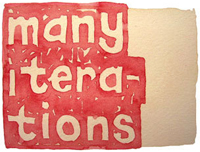
Have your Say, Workshop and more
1001 NIGHTS CAST News: THE THREE-QUARTER MARK; YOUR SAY; MOVING TIMEZONES; LONDON WORKSHOP.
THE THREE-QUARTER MARK: Sometime between tonight's performance (#750) and tomorrow's I will pass the three-quarter mark of the project. Since the two-third mark back in April, I'm very honoured to have performed stories by these new contributors to the project: Jordan Peimer (LA), Peter S. Petralia (London), Catherine Lord (LA), Adrian Heathfield (London), Sara Jane Bailes (Bristol), Karen Christopher (Chicago), Rinne Groff (NYC), Rebecca Schneider (NYC), Tony White (London), Geoffrey Batchen (NYC), Trevor Smith (NYC), Kate McIntosh (Brussels), Michael Grosberg (NYC), Hannah Chiswell (UK), Angela Piccini (Bristol), Lina Saneh (Beirut), Thalia Field (Paris), Alisa Lebow (London), Jane Gleeson-White (Sydney), Robin Bale (London), Branislava Kuburovic (Prague), Lara Pawson (London), Matias Viegener (LA), Kathryn Ryan (Sydney), James Tierney (Portland), Linda Dement (Sydney), Agnes Kocsis (London) and Nicholas Royle (London).
YOUR SAY: There is a new feedback section on the site. It's called Your Say. If you want to make a comment about a story, a performance or the project in general, please Have Your Say. You can choose to have it published on the site or to keep it private. If you want to see the published comments, hit the What You Said button.
MOVING TIMEZONES: The project moves to London on Tuesday July 17. That night, performance # 757 will be webcast at 9.10pm. That is: 10.10pm in Paris, Madrid and Prague 11.10pm in Jerusalem, Beirut and Istanbul 4.10am, July 18 in Perth, Hong Kong and Manila 6.10am, July 18 in Sydney 7.10am, July 18 in Auckland 4.10pm in New York, Toronto and Bogota 1.10pm in Los Angeles
LONDON WORKSHOP: Ten writers from the UK will join Barbara Campbell in London on July 20, 21 and 22 to write a three part story for the project. The writing workshop is part of DIY 4. DIY 4 is a collaboration between the Live Art Development Agency, Artsadmin, and New Work Network, and is being developed with Nuffield Theatre/LANWest, New Work Yorkshire, Fierce Festival, Colchester Arts Centre, The Basement Arts Production South East, and Dance4. DIY 4 is part of Joining the Dots, a Live Art Development Agency initiative supported by the Esmée Fairbairn Foundation and the Calouste Gulbenkian Foundation.
Posted by jo at 02:41 PM | Comments (0)
July 02, 2007
CONT3XT.NET / TAGallery
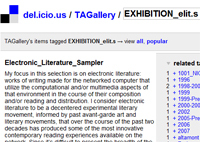
004_Electronic_ Literature_Sampler
TAGallery 004_Electronic_Literature_Sampler: [Scott Rettberg's] focus in this selection is on electronic literature: works of writing made for the networked computer that utilize the computational and/or multimedia aspects of that environment in the course of their composition and/or reading and distribution. He considers electronic literature to be a decentered experimental literary movement, informed by past avant-garde art and literary movements, that over the course of the past two decades has produced some of the most innovative contemporary reading experiences available on the network. Since it's difficult to present the breadth of the field in ten links, Ihe'll link to a few important collections of work and a few representative works among his personal favorites.
With projects/works by: The Electronic Literature Organization, N. Katherine Hayles, Talan Memmott (ed.), Ingrid Ankerson and Megan Sapnar (eds.), Ben Basan and Thom Swiss (eds.), Stephanie Strickland, Barbara Campbell, Robert Arellano, Rob Wittig, William Gillespie, Scott Rettberg, Dirk Stratton.
Tagger/Curator: Scott Rettberg is an electronic writer, and a founder of the Electronic Literature Organization. Rettberg is an associate professor of humanistic informatics at the university of Bergen.
TAGallery by CONT3XT.NET extends the idea of a tagged exhibition and transfers the main tasks of noncommercial exhibition spaces to the discourse of an electronic data-space. The method of tagging allows the attribution of artworks to different thematic fields. EXHIBITION_004 was tagged/curated by Scott Rettberg whose focus in this selection is on electronic literature: works of writing made for the networked computer that utilize the computational and/or multimedia aspects of that environment in the course of their composition and/or reading and distribution.
Exhibition
http://del.icio.us/TAGallery/EXHIBITION_elit.s
Tagger/Curator
http://del.icio.us/TAGallery/TAGGER_elit.s
Interview with Scott Rettberg
http://del.icio.us/TAGallery/TEXTS_elit.s
Posted by jo at 11:07 AM | Comments (0)
June 23, 2007
The Spam Oracle

When you cut into the present, the future leaks out.
"In 1959 Brion Gysin said that writing is 50 years behind painting, and applied the montage technique to words on a page ... Brion copied out phrases from newspapers and magazines, then took his scissors and cut these selections into pieces and re-arranged the fragments at random." – William Burroughs, Naropa Institute, 1976
In the late 1950s Beat writers William Burroughs and Brion Gysin discovered that "when you experiment with cut-ups over a period of time, you find that some of the cut-ups and re-arranged texts seem to refer to future events." The Spam Oracle brings the cut-up technique forward another 50 years, applying it not to the coherent world of linear, conventional texts, but to the increasingly bizarre universe of filter-dodging spam emails. What happens when these emails – already works of cultural pastiche in and of themselves – are cut up and randomly remixed? In what ways does the evolution of spam as an adaptive mash-up medium reflect who we are and where we're headed?
Ask The Spam Oracle a question, or tell it what's on your mind, and discover what secrets lurk between the lines. An ongoing piece by multimedia artist Jess Kilby, University of Salford Creative Technology program.
Posted by jo at 11:35 AM | Comments (0)
June 18, 2007
Bloomsday on Twitter
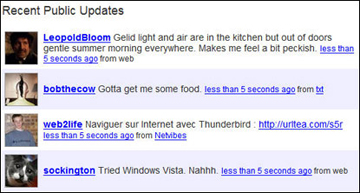
Bloomsday on Twitter: A performance of Wandering Rocks on Twitter, and a commentary on both. Created by Ian Bogost and Ian McCarthy :: I do not like Twitter, the micro-blogging service that allows users to send short (SMS-sized) text-based updates that are displayed publicly and shared with friends social-network style.
For me, Twitter represents the worst trends in the new internet culture. It purports to allow people to "communicate" in new ways, a promise that mostly creates new obligation and infatuation to stay "up to date" and "connected." In the world of Twitter, you (and me, and everyone) pay constant, tiny homage to a new gimmickry.
This is a gimmickry that doesn't even rise to the level of the gadget, with its industrialist promise of technological progress. It is a kind of softer soft-pornography determined to make identity-assertion the new masturbation. Russel Davies' Twitter parody Dawdlr comments on this trend, asking users to send updates via postcard.
In the world of Web 2.0, a public sheds the chains of a tightly-controlled mass media market in which individuals are converted into the "consumers" needed to purchase mass produced goods and services. In its stead, that public gets a loosly-controlled micro media market, in which individuals are converted into the "users" needed to create databases for sale to Google or Yahoo! or News Corp for $35 a head. But now the market outsources manufacture to those very "users." The workers may have had nothing to lose but their chains, but the users are lining up to link their own together. It's the new fashion; chains are the new black.
Invective like this may amuse, but it doesn't necessarily change opinion or create discussion. My friend and sometimes-collaborator Ian McCarthy and I had been talking in San Francisco recently, looking for an intervention that would both comment on Twitter as a social force and also attempt to use the service in a culturally interesting way. What if the focus on socialization and identity is actually the least interesting way to use Twitter?
So, here's what we came up with.
Today, like every June 16, is Bloomsday, a holiday that celebrates James Joyce and his novel Ulysses, which takes place on this date in 1904. Ulysses already offers a parallel commentary; Joyce conceived of the book's principal character, Leopold Bloom, as an everyman counterpoint to Odysseus, whose adventure Bloom's parallels. Each of the book's 18 chapters take place in roughly an hour's time.
The 10th of these, Wandering Rocks, follows 19 Dubliners walking through the city, doing their daily business, some intersecting with others. It's a famous and often-studied section of the book, one that also speaks to an experience of urban modernity that has become second-nature to us now.
Enthusiasts often retrace the characters' steps on Bloomsday, and innumerable animated maps and the like have been created by fans and scholars. The latter technique still doesn't really represent the interleaved simultaneity of Wandering Rocks, the complexity yet ordinariness of space and interaction that Joyce's writing accomplishes. And the former technique turns the ordinariness of the episode into a kind of theme park, missing the importance of the Wandering Rocks as a vignette of the scenario that grounds the rest of the novel (I've written about this theme more in relation to videogames in a chapter of my book Unit Operations).

We took Wandering Rocks and adapted it into a large series of 140-character or less utterances in the first person. We organized and timed these and built a database for them. We registered key characters in the novel as users on Twitter. For example:
STEPHENDEDALUS: I see Dilly's high shoulders and shabby dress, shut the book quick, don't let see.
Then we wrote some software to automate the performance of Wandering Rocks on Twitter, so basically we just turn it on and it runs. The result, we hope, will offer both an interesting and unique perspective on the novel and on Twitter. I'll let our critics be the judge of that.
Bloomsday tradition normally demands that festivities take place on Dublin time, which is unfortunately 6 hours ahead of the US East Coast. Wandering Rocks starts at 2:55pm, which is barely the crack of dawn (especially on a Saturday) out on the West Coast. So we decided to synchronize our performance to EDT. If you wish, you can watch the public stream on Twitter starting at 2:55pm EDT. You can also watch the individual characters, or even add them as "friends" to get the updates.
Update: the performance is now completed; while there were a few hiccups that made a very small minority of the characters unable to participate, the vast majority worked as planned, and you can now click through to read their contributions. I'll put together some documentation of the live version to share soon.
BUCKMULLIGAN
STEPHENDEDALUS
[go to post for live links]
LEOPOLDBLOOM
BLOOMSCAT
BLAZESBOYLAN
JOHNCONMEESJ
ONELEGGEDSAILOR
WIFEOFSHEEHYMP
BRUNNYLYNAM
DENISJMAGINNI
MRSMGUINNESS
BLONDEINTHRNTNS
HELYS
MISSDUNNE
TOMROCHFORD
SATCHELLEDBOYZ
NOSEYFLYNN
MCOY
LENEHAN
JJOMOLLOY
UNLABORINGMEN
CORNYKELLEHER
CONSTABLE57C
THESHOPMAN
EARLOFDUDLEY
OLDWOMANONTRAM
PATRICKDIGNAM ALMIDANO
THELACQUEY
DILLYDEDALUS
SIMONDEDALUS
HAINESINDUBLIN
JOHNPARNELL
ELIJAHISCOMING
KATEYDEDALUS
BOODYDEDALUS
MAGGYDEDALUS
MISTERKERNAN
NEDLAMBERT
CLERGYMANJACK
FRBOBCOWLEY
DENISBREEN
BENDOLLARD
CASHELFARRELL
BLINDSTRIPLING
DUDLEYWHITE
RICHIEGOULDING
THEPODDLERIVER
2SANDEDWOMEN
THEPOLICEMAN
MARTNCUNNINGHAM
JOHNWNOLAN
HORNBLOWER
MANINMACINTOSH
Late last night, partly to test and partly to put a stake in the ground, we did perform the first ten minutes of the novel properly synchronized to Dublin time.
Happy Bloomsday!
[blogged by Ian Bogost on bogost.com/blog] [Related]
Bloomsday On Twitter
Perhaps one day we will remember Twitter as the peak of exhibitionism on the Internet, a phenomenon that started with blogs and social networks. It is hard to imagine anything more compulsive: Twitter is a community of thousands of people who publish brief messages answering the simple question "what are you doing right now?". It is a sort of self-imposed big brother, a Babel of self-referential statements ("I'm checking my email", "I'm buying a computer on eBay"), a massive collective stream of consciousness. On June 16, in Dublin, there are celebrations for the Bloomsday, a day of cultural activities centered on James Joyce's Ulysses. Among the most important events of that day is the reenactment of day of Leopold Bloom, the odissey of the common man that unravels on the streets of Dublin in a single day. What do the most important novel of the twentieth century and the most extreme platform of web 2.0 have in common? Nothing, or so it was before the last June 16, when Ian Bogost and Ian McCarthy, game designers and non-linear narration researchers, chose Twitter as the stage of a strange online performance. The tenth chapter of Joyce's Ulysses, that narrates simultaneously the lives of nineteen citizen of Dublin was adapted to microblogging. The original text was broken down into fragments and inserted into a database for a computer program to read and publish as messages on Twitter at the right times, signed with the names of the characters/users. The result is a bizarre short-circuit between time and space units, between high and low culture. Characters from a novel are animated by a machine and their voices mix with those, paradoxically more artificial, of real human beings. The performance, coherently with the pace of that chapter, lasted only an hour, and it probably wasn't noticed by the users of Twitter, lost as a drop in an ocean of communicating solitudes. - Paolo Pedercini, Neural.
Posted by jo at 06:49 PM | Comments (0)
June 08, 2007
Nico Vassilakis - Visual Poetry In The Continental Review
Poet Nico Vassilakis in May 2007 presents five short works of video poetry in The Continental Review.
Posted by jo at 11:36 AM | Comments (0)
May 23, 2007
Poetry in Paris: 2 Reviews
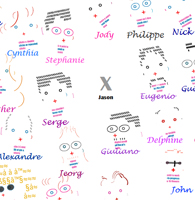
ePoetry and E. Kac
"...This May, Paris was *the* place to be for digital, experimental, new media poetry, and because there was 2 major events, the "critical mass" was reached and made more obvious that this field is truly challenging.
The first event is epoetry. Everybody (or almost) that counts in digital and new media poetry was there, from all over the world : the pioneers, the big names, the about-to-become-big-names, the new emerging generation. Too many names to list ! Epoetry is first an academic conference that I could not attend, but the proceedings will be online. It is also a series of events that took place in several locations in Paris and the near suburbs. All of them were very well attended and the programme was brilliant. I could not see everything and again, links to the artists web sites are on the epoetry web site, so please go and have a look. I just want to point some works and artists that I saw and that were absolutely brilliant:
- Jörg Piringer, that does generative work in real time, where the text is "animated" by his voice. It is what you would call "P-Jing" for poetry-jing. This seems to be a new very interesting tendency : to mix live texts
- Aya Karpinska, in the same vein, showed live "poetry fights"
- Patricia Rydzock performed digital haikus associating images and texts
- The Montreal-based Agence Topo presented and performed the web-based piece "Astres / Stars / Goleuadau" created by Childe Roland that is in English, French and Gaelic
- Eugenio Tisselli presented his "Degenerative" project, a text that destroys itself when the viewers come and see it online. He also showed a new project that is an algorithm to create automatically blogs and also comments. This is smart and fun.
Again, it would be too long to even describe the (small) portion of what I have seen, so check it on e-poetry web site. The two things I want to point out are:
- Digital poetry is more and more associating texts, images and sound in a kind of combination of sound poetry, visual poetry, hypermedia poetry and generative poetry in new ways and forms. It is online, off line, in performances, etc. and uses all possible media and forms.
The Second event is the Biennale Internationale des Poètes en Val de Marne (Poetry Biennal), under the direction of Jean-Pierre Balpe, a key figure worldwide for generative poetry. It takes place in various places in Paris and the Parisian Area (Ile de France). It is until June 2nd. It deals with all kind of poetry, digital, non-digital, experimental, new media, etc. No conference here but many exhibitions, lectures, performances, etc. Yesterday night, in this framework, I saw an exhibition of Eduardo Kac's poetry that includes 2 holopoems, a videopoem, a 3D interactive poem and a new work that is a bio poem. You can go to E.Kac's web site to read the description that would be too long in that email. I just want to say that a "living poem-picture" is something that may look simple and that is actually incredibly moving and challenging the art form. I will try to write a short article about it..."
Annick Bureaud (via Yasmin)
Review by Simon Biggs:
Multimedia, multiculturalism, language and the avantgarde
Notes and observations from ePoetry 2007
May 20-23, Universitaire Paris 8
ePoetry is a series of international colloquiums and artist¹s presentations held biennially at various locations around the world. Previous events have been held at the State University of New York, Buffalo (2001), the University of West Virginia, Morgantown (2003) and Birkbeck College, University of London (2005). It proclaims itself the most important of international festivals of digital poetry. Given that it is the only such regular event dedicated to digital poetry this claim is indisputable.
The event takes the form of an academic conference strand during the day, involving a mix of peer reviewed academic presentations and artists' round table discussions, complemented by evening performances, presentations and mini-installations. As with all such events the range of works and perspectives on practice and theory presented was diverse and not necessarily coherent. It is not surprising that artists and academics in this field come from diverse countries and cultures. Whilst there was a large presence from France and a good number from the US and other English speaking countries there was also a refreshing number of practitioners and theorists from South America, southern and Eastern Europe. The lack of any representation from Asia or Africa suggests that either the international reach of this event is not complete or that this area of practice and research exists in those cultures where there are the necessary precursor artistic traditions in place; practices such as concrete and visual poetry, performance poetry, interactive media arts and networked arts.
Paris is incredibly multicultural but the dominant culture of France remains founded in the high (Western) traditions of the arts. Paris's colourful and ethnically diverse street culture rarely seems to connect with this official culture, especially in the visual and literary arts (music is a different story, Paris being the World's world music capital). France is torn between its constitutional commitment to a unified French identity and the actuality of its contemporary multiculturalism. Nevertheless, it is still a likely site for any reconciliation between Western Liberalism and other cultural traditions. Whether recent political events in France, dominated by debate on immigration and French identity, will accelerate any process towards reconciliation or lead to worsening conflict is yet to be seen. The consensus on the left is that things will get worse before they get better but as has been seen elsewhere (e.g.: Northern Ireland) it can be the case that it is when the most extreme of positions are brought together that significant reconciliation becomes possible.
This larger political and social context, within which ePoetry 2007 was held, was reflected in much of the events content, both explicitly and implicitly as well as through absence (e.g. the already noted absence of Asian and African perspectives). Chasms of cultural conflict were also played out amongst mainstream players. American feminists were outraged by a performance work involving a female artist stripping under the video gaze of her male partner. When the Americans' later asked the artists "would you consider reversing roles" the male performance artist replied "if I had a sexy body then I might be willing to reveal it". There was no evident irony in his reply and he clearly failed to comprehend the American (and general) amazement that 30 years of feminist discourse had clearly had little effect in this context.
The conference strand was, not surprisingly, a babel of languages reflecting the diversity of its participants and its multicultural context. Much was lost in translation. One comment on torture at Abu Ghraib was translated as torture in China. That there were no Chinese present meant insult was avoided. As already observed, conflicts can emerge where they need not and meanings can be radically misplaced. To the writer and artist such accidents can be serendipitous, but in a world ultra-sensitised to difference such errors can prove explosive. In a less dangerous but nevertheless highly pertinent example, poetry and poetics were regularly conflated as the same, failing to recognise that poetry is a practice involving language (and thus is poetic) whilst poetics is a more fundamental concept concerning the relations between things. Poetics is not concerned with practice but with the (dis-)ordering of things.
Much of the initial discussion in the conference focused on the relation between the avantgarde and digital poetics. The premise was that digital poetics represents a new avantgarde and that from this it follows that digital poetics is a good thing. That the avantgarde can only exist in relation to a largely homogenous society is overlooked in this argument. Contemporary heterogeneous social environments do not offer the easy target of a mainstream or bourgeoisie against which an avantgarde can differentiate itself. As we have seen on the streets, Paris is a truly multicultural environment. There is no mainstream. It is only within the bubble occupied by a certain cultural elite that the notion of the avantgarde seems to be sustainable. That it is an historical rather than contemporary paradigm did not seem to have revealed itself to many of those involved in this debate and thus the resulting discussion seemed disconnected from current artistic and social realities.
In a society of a thousand heads there is no place for the avantgarde to differentiate itself from its social body. This body, which was once an obese mainstream presence, has withered to a skeletal foetus, sucked dry of its life by a thousand hungry heads, each concerned with its own existence. In France we see this change played out between street level culture and the social and political elite, distanced from the noisy and messy reality "outside". Post modernist relativism, the historic intellectual response to this shift from mono to multicultural social formation, has dispensed with the grand themes of the avantgarde. Without a return to a narrow definition of society the social body the avantgarde needs to feed off will remain desiccated and unable to offer nourishment to what was always the obverse of that which it sought, and failed, to transcend.
In the same way that cultural diversity is framing the context of contemporary social discourses it also informs the underlying hermeneutics that inform knowledge/language and its relationship to power. Tectonic social changes are breaking down previously homogeneous structures leading to a steady erosion of the culturally specific signifier as the means to power. Specifically, and of particular relevance to ePoetry, text is under threat from the multicultural visual pidgin we are now all familiar with from television, advertising, airports and environments where diverse peoples come together. This is a pidgin that is largely pictographic and iso-semiotic in its sign structure. A new hermeneutics thus arises where this pictographic pidgin supplants text, evolving towards a reductive, isomorphic, non-abstract and semiotically debilitated language field.
This process could be seen to be determined by technological change, as a function of digital media convergence. However, it now becomes clear that the underlying factor in all this is likely not to be technological but cultural change the cultural force majeur of international migration and the global movement of human populations. That this dynamic and unsettling process of global social change is only going to accelerate, perhaps driven by environmental change, will likely lead to the further debilitation of the word in favour of a visual hermeneutics that allows for more diverse sources of authority in signification, reflecting and facilitating a multicultural world premised on multi-polar cultural origins. That a side product of this process is likely to be further conflict between a currently dominant Western Liberalism and other emerging cultural paradigms cannot be ignored, although such issues were not articulated at ePoetry 2007.
Putting aside the context of ePoetry 2007 and the discourses that might spin out from that, there were a number of very interesting contributions by both theorists and practitioners. Convened by Phillipe Bootz and Patrick Burgaud (University Paris 8), the key presenters included Philippe Castellin, Jean Clement, Tibor Papp (France), Jay Bolter, Loss Glazier, Charles Baldwin, Alan Sondheim, Chris Funkhouser, Eduardo Kac, Jim Andrews, Stephanie Strickland, Talan Memmott (USA), Friedrich Block (Germany), Marcus Bastos (Brazil), Janez Strehovec (Slovenia), Annie Abrahams (Holland) and Ambroise Barras (Switzerland).
Much of the work performed over the three live evening events remained rooted within the performance poetry tradition. Flash animations illustrating word play rarely manages to add anything significant to the oeuvre and certainly such works do not propose any significant shift in how a digital poetics practice might evolve. Many works presented thus failed to transcend being illustrated poems. To my mind there seems a similarity here to the dead hand that Powerpoint passes over academic presentations, with Flash functioning to banalise what might be potentially interesting textual projects and performances.
Lucio Agra and Paolo Hartmann performed a witty, playful and visually engaging VJ set. Language definitely played second fiddle in this work, with the visual and aural to the fore, but at least these two instruments were played in tune. A typically anarchic and visually rich Brazilian mix was projected around and over the audience whilst the performing duo sat more or less motionless on stage. The potential readings available in this work remained, for this observer, obscure. However, the visual invention involved never failed to engage and thus it was, at the very least, an enjoyable distraction.
Jeorg Piringer's performance involving voice activated textual visual elements in a large scale digital projection was similarly engaging in a straight forward manner. Simple in presentation and concept, this performance relied on the capabilities of the performer and the cleverness of the code used to create the work. However, this work was not as technically innovative or as artistically ambitious as Messa di Voce (by Golan Levin, Zach Lieberman, Jaap Blonk and Joan La Barbara) and for anybody familiar with this prior piece Piringer¹s efforts were thus diminished in effect, even though his work could be regarded as more pure in its intent and concern with language.
Jim Rosenberg, an icon of literary experimentalism and a pioneer of digital poetry, gave a thoughtful and well judged presentation of his new software authoring interface, "The Inframergence". Complex in structure but visually minimalist and strikingly elegant in realisation, this is a very serious work that offers not only a sophisticated engagement with how language can come to signify but also poses important questions about the nature of writing, interpretation and semantics. That a number of theorists immediately engaged with this work during the conference strand was not surprising. Such work will attract theoreticians like bees to honey.
However Rosenberg's impressive contribution was immediately left in the shade by two young authors who performed on the same programme. I am sure that Rosenberg was heartened by thie evidence that digital poetics is not only a practice involving middle aged white men. Aya Kapinska (Poland/USA) performed a textual Playstation hack as a techno club dance come computer game performance (in the style of Wii). The rhythms and alliterations were given immediate effect and the spoken word came again to life as we saw texts flying around in an abstracted psychadelic 3D world, paced to a dub beat. This work relied as much on the competence of the performer (Kapinska) as on the technical and conceptual strength of the audio-visual component.
Eugenio Tisselli (Mexico/Spain) presented his works "Degenerative Page" and "Regenerative Page". These two works offer a perspective on a kind of practice that was surprisingly not more visible at ePoetry 2007. These are the practices we are familiar with from Net.Art, from the work of JoDi and Kosic and their anarchic and playful reverse engineering of the means of production and dissemination. Tisselli's works developed this theme further than many precursors in novel ways and his plans for world domination through a multi-lingual practice suggest new directions for net based art at a time when many commentators (not least the first generation of Net.Artists) have declared net art dead. Noting the overarching themes, articulated at the outset of this text, Tisselli's work engaged with mutliculturalism and the pursuant limits of written language and its technological infrastructure in an explicit manner whilst remaining at all times subtle and problematic.
Ever-young John Cayley's "Imposition", based on a text by Walter Benjamin (On language as such and the languages of man), was a visually engaging work which was, by his standards, relatively minimalist. This is a work that brings language to life, a language composed of multiple languages, colliding and creating a frisson between themselves. In a sense this multilingual play could be seen as a metaphor for the entire conference, a playful cacophony of voices in distinct yet merging languages, discursively engaging one another rather than articulating in parallel. In Cayley's work members of the audience login to a common remote server and interact with a generative multilingual language machine, this in turn creating a visually simple but conceptually complex display projected on a large scale in the conference auditorium. As well as the imagery there was also a vocal soundtrack; a female voice articulating in song the phonetics involved in the textual constructions. An abstract soundscape, being essentially non-semantic, it gained great complexity and interest as more and more people logged on and their dispersed computers began to replicate, out of phase and with differing timbres, the vocalisations around the auditorium space. The result was a complex and dynamic spatialised sound sculpture composed of the human voice, evoking a sense of the multiplicity of the voice, language and the pre-linguistic.
Roberto Simanowski presented a close reading of the work "Listening Post" by Mark Hansen and Ben Rubin. His analysis read the work as being at the juncture of and as a function of a tension between the visual (image, installation) and language (writing, voice). This work is well known but seeing good quality documentation and listening to Simanowski's detailed analysis brought it to life and opened up new interpretations in a piece that could be regarded as a slick technologically determined artwork, the sort of thing that wins Golden Nica's. Simanowski's final observations appropriately reflected on how technology will inevitably come to cannibalise language.
This gave this observer reason to consider the implications of Stanislaw Lem's "The Futurological Congress", a novel set within the context of an academic conference, not unlike ePoetry 2007, where the main protagonist awakes in a future world to find that the relationship between people and their language has been inverted and the instruments of writing have come to master the writer. Leaving Paris I wondered whether the revolution Lem described, where both society and its technologies are torn apart and reconfigured, might not only come to pass but be in process right now.
ePoetry 2007 has established its post-conference website, which will continue to be updated with material. It is expected to include the complete peer reviewed set of academic papers (bi-lingual where possible) as well as documentation of artists work. Its url is www.epoetry2007.net
Simon Biggs
Paris/Edinburgh, May 2007
http://www.littlepig.org.uk/
Research Professor in Art, Edinburgh College of Art
Posted on iDC -- mailing list of the Institute for Distributed Creativity
Posted by jo at 06:28 PM | Comments (0)
May 22, 2007
Chyphertext Performance
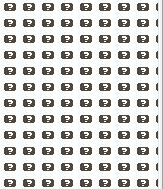
Networked Writing Performance
Chyphertext Performance by Bjxrn Magnhildxen/noemata :: TIME: May 23, around 22h - 23h (CEST) :: OFFLINE: Le Cube, Paris :: ONLINE: http://noemata.anart.no/cp/.
This is an networked writing performance that consists of a hybrid of human / machinated real-time writing and reading. The writing is performed by (1) plain computer keyboard writing, (2) server-based machinated, algorithmic writing, (3) interactions from from readers online, (4) text feeds from the processes surrounding the writing (like system monitoring, net connection monitoring, ftp logging, website hit statistics logs, etc), (5) data transformation - the writing is transcribed into streaming music as midi-event, and the images are transcribed as text/code and then into music.
All this semi real-time, the lag can be some seconds from input to output. The format of the writing is plaintext, ciphertext / code, and hypertext. For convenience the performance is streamed over the web in a regular browser. The piece is made especially for the e-Poetry 2007 festival.
Both these chyphertext- and plaintext performance pieces are parts of a project called 'protocol performance' that i will be doing from remote through 2007. Protocol performance and then Chyphertext Performance is supported by the Norwegian Cultural Council, Art and Digital Technology. Also thanks to Atelier Nord for hosting noemata and the event on the server.
References
* @ E-poetry 2007: http://www.epoetry2007.net/artists/oeuvres/bjorn/bjorn.html
* CV: http://noemata.anart.no/puh/cv.html
* Plaintext performance: October, 2006. Plaintext Performance. @ Tate Modern, London, e and eye - art and poetry between the electronic and the visual. Organised by Penny Florence and Tim Mathews, with John Cayley. Curated by Charles Baldwin and Alan Sondheim: http://www.tate.org.uk/modern/eventseducation/talksdiscussions/6703.htm; http://web.mac.com/shadoof/iWeb/eandeye/; http://noemata.anart.no/pp/transcript/eandeye/. A transcript of the Plaintext Performance at Tate Modern is available at: http://noemata.anart.no/pp/transcript/eandeye/Plaintext%20Performance%20-%20Bj%F8rn.Magnhild%F8en-noemata.html
* September, 2006. Plaintext Performance. @ BIOS symposium, West Virginia University. Hosted by the Center for Literary Computing and the Division of Art at West Virginia University. Part of the E-Poetry Symposia and Festivals. Co-organized with the Electronic Poetry Center and Digital Media Studies Program (SUNY-Buffalo). Curated by Charles Baldwin and Alan Sondheim.
http://www.clc.wvu.edu; http://clc.as.wvu.edu:8080/clc//bios_flyer; http://noemata.anart.no/pp/transcript/BIOS/.
CEST = central european summer time = UTC/GMT +2 hours. In other timezones the performance will be:
England: 21:00 - 22:00 (UTC +1)
US Westcoast: 13:00 - 14:00 (UTC -7)
US Eastcoast: 16:00 - 17:00 (UTC -4)
Australia: 06:00 - 07:00 (UTC +10)
(see eg. http://www.timeanddate.com/worldclock/)
Posted by jo at 11:20 AM | Comments (0)
March 22, 2007
Introducing The Artmob (beta): Benjamin Thomas

Subscribe Now!
The Artmob is pleased to announce its pilot project from artist Benjamin Thomas. Benjamin's work on OBFAT introduces "Original Advice and Inspirational Phrases" to the public under a Creative Commons Attribution Share Alike licence. Phrases are sometimes matched with typeset and graphics by Benjamin.
For 30 days, Benjamin Thomas will be broadcasting phrases, graphics, and calls for participation via SMS/MMS direct to subscriber's mobile phones through The Artmob. To find out more and subscribe please visit TheArtmob.net.
The Artmob is a new project currently in its pilot stage. We are devoted to curating and commissioning art for mobile devices. Artmob will also provide resources for artists to create mobile content in effort to expand the dialogue on mobile media into the artist realm. For more info and contact information please visit TheArtmob.net.
Posted by jo at 10:07 AM | Comments (0)
March 16, 2007
Begin your day with the Breakfast Blogs

Exploring the Political + Social Mission of Artistic Practice
BREAKFAST AT PAVILION (A PROJECT INITIATED BY PAVILION MAGAZINE IN THE FRAME OF BUCHAREST BIENNALE) :: BREAKFAST (online) is a series of blogs kept by theoreticians, political analysts, anthropologists, artists and curators. BREAKFAST explores on a theoretical level the political and social mission of artistic practice with its necessity of being contextualized. The blogs are written in English or Romanian depending on each participant`s option. The project has also a live form that includes public debates and conferences on the same issues within social political and aesthetic discourses as discussed online.
BREAKFAST seeks to transcend the traditional borders between research, education and presentation and looks for new ways of expression and communication trying to find new answers to some old questions related to politics, aesthetics and content and to reevaluate the conventions of everyday life. Considering all these, BREAKFAST investigates subjects like rhetoric, populism, technology, humanism, politics, relativism, solidarity, post colonialism or inclusion by means of curatorial, artistic and educational projects.
The first bloggers involved in BREAKFAST are Catalin Avramescu (Professor of Political Science, journalist and political analist), Eugen Radescu (theoretician, curator and co-director of Bucharest Biennale), Felix Vogel (theoretician and curator) and Razvan Ion (theoretician, artist and co-editor of PAVILION magazine). PAVILION magazine is developing its own blog as an informative platform / structure.
The project director of BREAKFAST is Andreea Manolache and the online version is technical designed by Alexandru Enachioaie (alexandru.e[at]gmail.com). Blogs available at http://blogs.pavilionmagazine.org
PAVILION is an international contemporary art & culture magazine whose name alludes to the relative temporary structure of contemporary art. PAVILION`s content varies from articles to essays, interviews and projects`presentations. It is not just a descriptive magazine, its mission is to intervene in cultural and socio-political life.
PAVILION is the producer of BUCHAREST BIENNALE.
PAVILION, BUCHAREST BIENNALE & BREAKFAST are projects of artphoto asc.
office: +4 031 103 4131
mobile: +4 0726 789 426 | 0723 033 330
ym: artphotoro
skype: artphotoro
address: PO Box 26-0390 Bucharest 14800 Romania
Posted by jo at 12:22 PM | Comments (0)
March 14, 2007
The Living Script
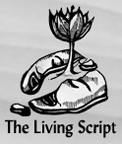
Collaborative Playwriting
A new collaborative playwriting project, The Living Script, has just been launched by Chicago area artist Brett Hanover. The Living Script uses wiki technology to create an online, user-editable theatrical script.
Users of Wikipedia will be familiar with the format, though here the intent is to create a work of art constantly in flux - a script that never reaches its final draft. While collaborative writing projects have utilized wikis in the past, this is the first time the format has been used to create a stage play. Whatever develops from this unique process will be available for performance under a a free-media, Creative Commons license.
About Brett Hanover: A product of the burgeoning Memphis independent film scene, Brett Hanover debuted in 2005 with the short documentary "Above God," winner of Best Documentary at both the Indie Memphis and Atlanta Underground film festivals. This was followed by the experimental film "SCHIAVO," featured both at Indie Memphis and the 2006 Spun from the Web exhibition in Chicago. Since that time, he has directed numerous productions, including the critically acclaimed performance "S4TYR PL4Y," (2006) the first theatrical work to deal with anthropomorphic identity. Hanover currently attends the School of the Art Institute of Chicago, and is working on a feature documentary, "Bunnyland," set for release in '08. CONTACT: thelivingscript[at]gmail.com.
Posted by jo at 03:47 PM | Comments (0)
March 08, 2007
Gamer Theory
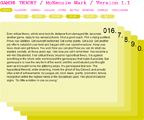
Visualize This!
How can we 'see' a written text? Do you have a new way of visualizing writing on the screen? If so, then McKenzie Wark and the Institute for the Future of the Book have a challenge for you. We want you to visualize McKenzie's new book, Gamer Theory.
Version 1 of Gamer Theory was presented by the Institute for the Future of the Book as a 'networked book', open to comments from readers. McKenzie used these comments to write version 2, which will be published in April by Harvard University Press. With the new version we want to extend this exploration of the book in the digital age, and we want you to be part of it.
All you have to do is register, download the v2 text, make a visualization of it (preferably of the whole text though you can also focus on a single part), and upload it to our server with a short explanation of how you did it.
All visualizations will be presented in a gallery on the new Gamer Theory site. Some contributions may be specially featured. All entries will receive a free copy of the printed book (until we run out).
By "visualization" we mean some graphical representation of the text that uses computation to discover new meanings and patterns and enables forms of reading that print can't support. Some examples that have inspired us:
Brad Paley's "Text Arc"
Marcos Weskamp's "Newsmap"
Chirag Mehta's "US Presidential Speeches Tag Cloud"
Kushal Dave's "Exegesis"
CNET News.com's "The Big Picture"
"Visuwords" online graphical dictionary
Christopher Collins' "DocuBurst"
Stamen Design's rendering of Kate Hayles' "Narrating Bits" in USC's Vectors
Brian Kim Stefans' "The Dreamlife of Letters"
Young-Hae Chang Heavy Industries
Understand that this is just a loose guideline. Feel encouraged to break the rules, hack the definition, show us something we hadn't yet imagined.
All visualizations, like the web version of the text, will be Creative Commons licensed (Attribution-NonCommercial). You have the option of making your code available under this license as well or keeping it to yourself. We encourage you to share the source code of your visualization so that others can learn from your work and build on it. In this spirt, we've asked experienced hackers to provide code samples and resources to get you started (these will be made available on the upload page).
Gamer 2.0 will launch around April 18th in synch with the Harvard edition.
Read GAM3R 7H30RY 1.1 .
Download/upload page (registration required): http://web.futureofthebook.org/gamertheory2.0/viz/
The Institute for the Future of the Book is a small New York-based think tank dedicated to inventing new forms of discourse for the network age. Other recent publishing experiments include an annotated online edition of the Iraq Study Group Report (with Lapham's Quarterly) and Without Gods: Toward a History of Disbelief (with Mitchell Stephens, NYU). Read the Institute's blog, if:book.
McKenzie Wark teaches media and cultural studies at the New School for Social Research and Eugene Lang College in New York City. He is the author of several books, most recently A Hacker Manifesto (Harvard University Press) and Dispositions (Salt Publishing).
Ben Vershbow
Institute for the Future of the Book
ben[at]futureofthebook.org
Posted by jo at 03:13 PM | Comments (0)
November 17, 2006
IF Comp 2006 Winners

Emily Short’s Floatpoint
The results are in, and Emily Short’s Floatpoint takes top honors at the 2006 Interactive Fiction Competition. The Primrose Path by Nolan Bonvouloir and The Elysium Enigma by Eric Eve placed second and third. Congratulations to these authors and to the others who finished games, entered them, and placed in the Comp. Another person who deserves thanks and congratulations is Stephen Granade, who has been running the Comp since 1999. All the games are still available for download, of course.
Reviews of games will be flowing freely soon, and I’ll try to add links to these in comments below. I certainly encourage you, if you are posting reviews yourself and are reading this, to add a comment with a link. [blogged by Nick on Grand Text Auto]
Posted by jo at 02:51 PM | Comments (0)
October 05, 2006
New Media Poetics
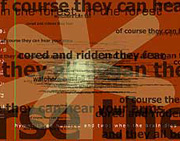
Leonardo Electronic Almanac
The category "New Media Poetry and Poetics" includes multimedia digital works (image/text/sound) as examined through the lens of "writing," specifically any of those concerns central to poetry rather than narrative or prose:
1. reader as active participant in the "ergodic" sense,
2. the use of stochastic methods and chance procedures,
3. the complex relations between the author, reader, and computer-as-writer/reader which evolve from that interaction,
4. modes of work that foreground the digital medium (such as "codework")
5. emphasis on "poetics" of new media writing, where aesthetics intersect with politics to create dynamic attempts at social change.
Posted by michelle at 07:36 PM | Comments (0)
October 04, 2006
E-poetry 2007
![]()
Call for articles and projects
Every two years, the E-Poetry series of Digital Poetry Festivals constitutes the most important digital literary gathering in the field. Authors and researchers worldwide meet and present their ideas and works. E-Poetry plays an essential role in the emergence of this new literary field, and provides a forum for the circulation of the ideas and the debates that animate it.
The festival has two facets: a university symposium and numerous artistic presentations. The symposium will take place at the Université Paris VIII. It will permit researchers to present their latest research and for artists to premier their newest works. Symposium papers will be published by Hermès Science Publications.
Artistic events will take place at key Parisian venues, providing notable authors the opportunity to present their works to a public curious about new literary and artistic trends employing technology and communication.
You are invited to submit a publishable article for the symposium. Maximum length should be 12 pages (Times New Roman 12). The article can be academic or can present an artistic work. Accepted languages are French and English. Criteria will be posted on Monday, October 2, 2006.
Articles must arrive in Word format via email to philippe.bootz@univ-paris8.fr in their final form by December 10, 2006, at the latest. Works must arrive at the latest April 15, 2006..
Details about criteria for artistic works will be posted on Monday, October 2, 2006. Interactive and/or generative works employing at least some programming are preferred. Works can be in art forms other than computer media, as long as they satisfy the criteria given below.
E-poetry 2007 is organized by:
The Electronic Poetry Center (EPC - SUNY Buffalo)
Le Laboratoire Paragraphe (Université de Paris VIII )
Mots-Voir
Opening Sunday, May 20. 2007.
Symposium and evening events: from Monday, May 21 to Wednesday, May 23, 2007.
The symposium will take place at the Université de Paris VIII (Saint-Denis), artistic works at le Cube and at Point Ephémère.
Organizers: Loss Pequeño Glazier, Philippe Bootz, Patrick-Henri Burgaud, Jean Clément, Alexandre Gherban
Information regarding the Symposium
philippe.bootz@univ-paris8.fr
Information regarding Works
pburgaud@laposte.net
Posted by luis at 12:06 PM | Comments (0)
June 24, 2006
Nathaniel Stern: Creative Commons Artist in Residence
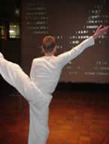
Shares [odys]elicit Under CC/GPL
Friday 23 June 2006, live from the iCommons iSummit:
[odys] elicit - a full-body, interactive art installation circa 2001 - is now available under a Creative Commons By Attribution Non-Commercial Share-Alike license, and the source code is available under GPL. It works with almost any standard webcam (requiring a few drivers on PC)!
[odys]elicit is a large scale, interactive installation where every movement of the viewer, small or sweeping, births stuttering text onscreen. The viewer’s motion elicits, character by character, passages from odys’ text. The piece responds to small movements, writing the text onscreen slowly for the viewer to read, or to rapid passersby, whose full bodies birth hundreds of flying characters, impossible to decode.
In odys’ work, viewers are forced to look at the spaces between language and meaning, the luxuries of stuttering and silence as communication, and the effects of accelerated and decelerated time. [odys]elicit physically places viewers at the center of co-invented noise, forced to perform - willingly or not. odys’ text has been reduced down to where it no longer has meaning and is re-birthed, with possibly infinite meanings, or none at all.
Click here to see videos of the piece in action.
Downloading:
Please first check out the read_me file - the PC application requires some extra (free) installs, and you can very easily change video settings or sources, input new text, toggle between birthing letters or full words, adjust the motion tracking tolerance levels given different lighting, or change the direction the text will go on the fly! Send me error messages if you encounter any bugs, or have much success! I am yet to fully test the OS 9 or PC versions. Oh, and about any parties or exhibitions that this thing is a hit at, too ;)
read_me.rtf
OS X Application
OS 9 Application
PC Application (still testing)
Source Code (in Director/Lingo + TTC-Pro; demo versions of these will work)
@ Rio iSummit [posted by nathaniel on nathanielstern.com]
Posted by jo at 10:38 AM | Comments (0)
April 25, 2006
Quoth

NetJamming with Ominiscient Interpreter
Quoth is a dynamic interactive fiction system, in which authoring is done from a player's perspective, from within the running work. Quoth draws upon the concepts of pervasive anthropomorphisation, executable natural language, and revisionist narrative. The major use of Quoth so far has been for musical livecoding.
In traditional interactive fiction, the player speaks to an ominiscient interpreter. There may be dialogue with "non-player characters", but it is mediated by the interpreter. In Quoth the player is always speaking directly to some item in the universe. The traditional omniscient interpreter is represented by the universe itself. This allows for each item in the universe to have a different vocabulary, or even a different "interpreter" altogether. It also provides the player with more fluid interaction with each item...
Posted by jo at 08:14 AM | Comments (0)
April 24, 2006
Barszcz.net

Gourmet programming
'Barszcz' [often written 'Borscht'] is a traditional Eastern and Central European soup of red beetroot that comes in many regional and seasonal varieties. The 'Barszcz.net' website presents a recipe for Ukrainian Barszcz and a first contribution to its source code repository: Jaromil's 'string based cooking' written in the programming language C.
Barszcz.net stresses the parallel between programming and recipes in a cookbook as a set of instructions to follow. Like cooking recipes, examining the source code of a particular program reveals information about the software in much the same way as the ingredients and set of instructions of a recipe reveals information about the dish to be prepared. The analogy reveals something of the interests involved in the preparation, execution and consumption of the (software) work. Both programming and cooking can express intentionality, style and should be accompanied with a health warning. All source code/recipes submitted to the repository are released under the GNU General Public License.
Barszcz.net is looking for further entries to add to the repository in a range of programming languages. If you have any barszcz source code that you would like to share, please email 'info at barszcz.net' (replace word for symbol before sending).
Barszcz source code repository http://www.barszcz.net
Posted by luis at 04:26 AM | Comments (0)
December 12, 2005
Ruark Lewis and Rainer Linz
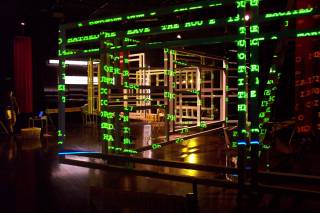
Banalities for the Perfect House
Banalities for the Perfect House--by Ruark Lewis and Rainer Linz--is a collaborative installation & performance work premiered at Sydney's Performance Space theatre on Sept 9 2005. The work proposes the house as a condition through which we perceive the world - the city an extension of grid-like structures viewed through the "frame" of an open window.
Performance texts are distilled from everyday sources including newspapers, cookery books, and snippets of overheard conversation. They consist of seven Banalities: Banalities for the Perfect House, Banalities for Napoleon, Banalities for the Modern Kitchen, Banalities for Solid Mandala, Banalities for Newspapers, Banalities for the Times and Misreading Barricades.
The texts are inscribed on all architectural surfaces, and take the form of performance scripts as well. These include cards, looseleaf and bound pages, and word sequences printed on ticker tape.
The sound is performed on five computer terminals and distributed through a 4-loudspeaker sound system. It is performed using real-time computer processing of original vocal samples, in turn derived from the written texts. The computer sound-generating software was purpose-written for the piece.
The performance space is arranged with wooden frames, boards and barriers resembling, in abstract form, a housing construction site. Each surface is rendered with text creating an immersive environment that can literally be read, and heard as speech.
The work is built around a series of duet and solo performances. Each is based on an individual text, which is the common basis for both the computer and vocal renditions.
The Perfect House is a construction site for ideas, with performers and audiences traversing it as if through rooms made from words whose meanings, too, are still under construction.
Posted by jo at 12:36 PM | Comments (0)
October 13, 2005
LiveMarks

Live del.icio.us Bookmarking
"Imagine if you could see the most popular links and most recent bookmarks live."--Alex Bosworth, LiveMarks.
LiveMarks is a project to show del.icio.us bookmarks live. On the left of LiveMarks you can see most recently popular bookmarks. On the right, del.icio.us bookmarks scroll by as people bookmark links on del.icio.us. Clicking on .oO links launches them in a new browser window.
Posted by jo at 11:56 AM | Comments (0)
Towards Tag Poetry

Organic Data Clouds
"...In general, however, the tags tends to be a second-order supporter of digital art, not the focus. I have not yet seen a poem or a short story written entirely in tags. There are some intriguing possibilities - for example, TiddlyWiki supports tagging of individual entries in a way that might help the development of tagged wikifiction - but so far the artistic excitement and energy around tags seems to be around the infrastructure enabled by them or the data visualization techniques built on top of them, not making specific statements through them.
There are however a few examples of writing with tags, rather than above or around them. One is the header of We-Make-Money-Not-Art, which uses a tag-cloud navigation display in lieu of a subtitle, tagline, about blurb, or anything describing what the site is and what it does. The tag cloud is an organically changing navigation tool, and it is the description of the site as well. (There may be a other sites which do this, or even did it first - I’m just not familiar with them)..." Read full post >>
Posted by jo at 08:42 AM | Comments (0)
